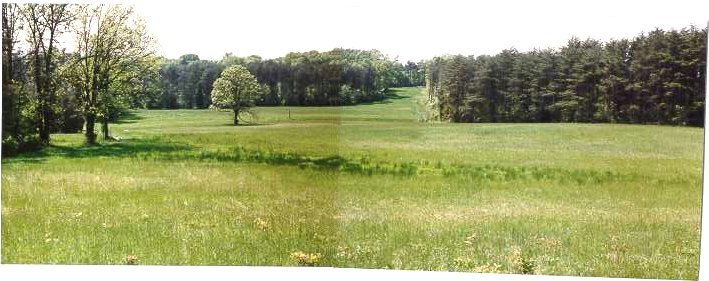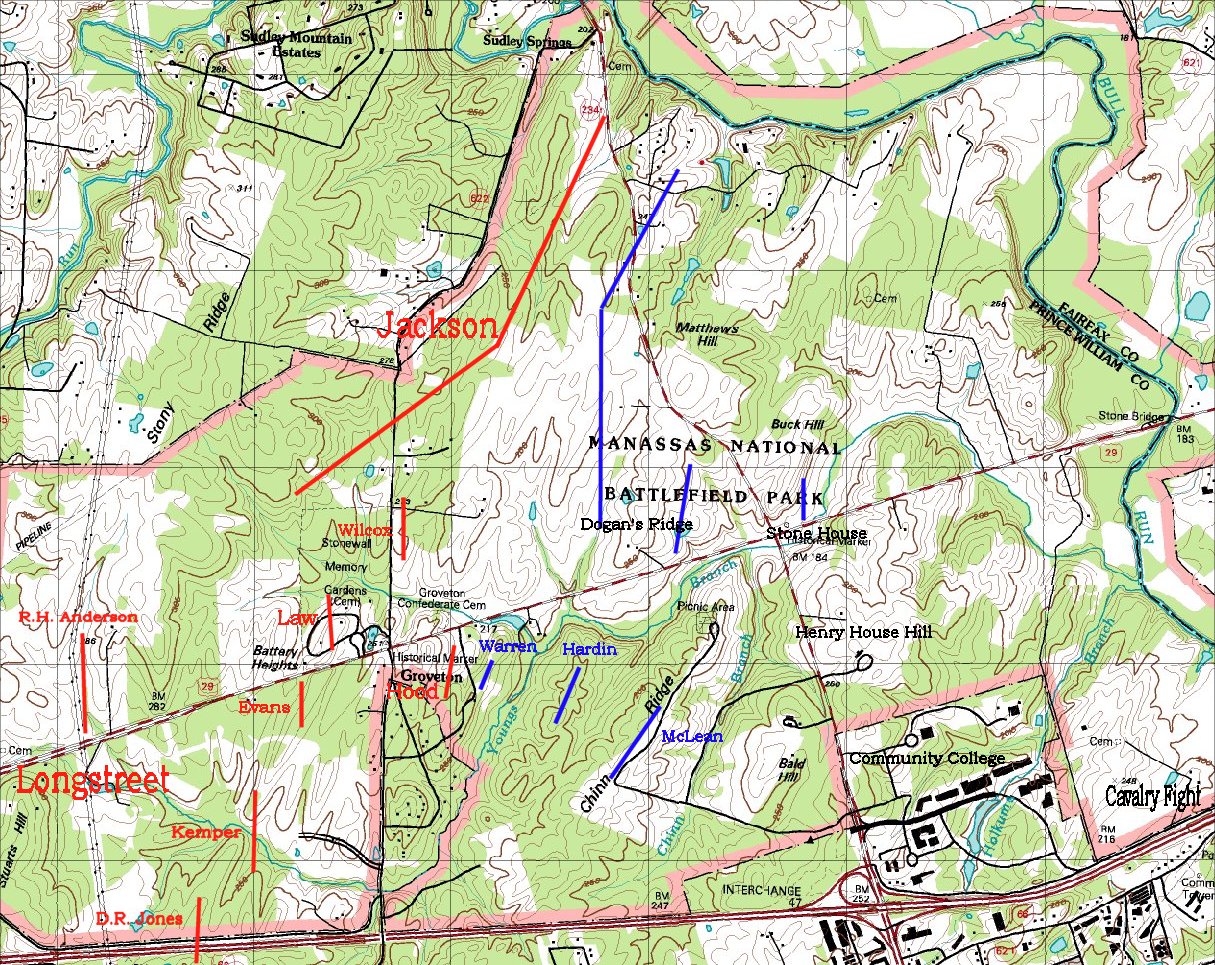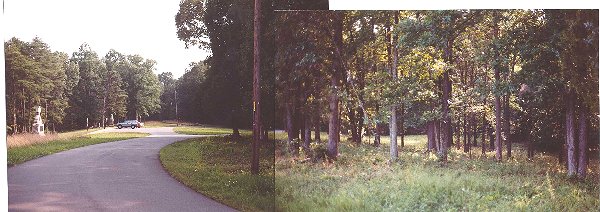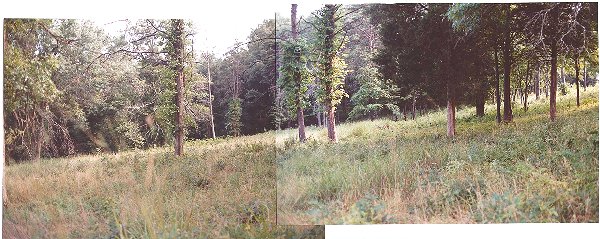
Second Manassas
August 30,1862
After Lee defeated McClellan in the Seven Days Campaign, Pope's Army of Virginia remained a threat in Northern Virginia. Jackson was sent north to protect the vital rail center at Gordonsville. After Jackson narrowly defeated one of Pope's three corps at Cedar Mountain, Lee decided to take the rest of his army north. McClellan's army was withdrawing from the Peninsula, and Lee had to defeat Pope before the two joined. Pope's 55,000 and McClellan's 90,000 men could together muster 140,000 men to Lee's 55,000. After a failed attempt to move into Pope's rear, Lee faced his enemy across the Rappahannock.
On August 25, 1862 Jackson's corps began the march around Pope's army, and Longstreet's corps followed the next day. On August 27th, Jackson's men plundered the Union warehouses at Manassas Junction while Pope moved to "bag" him. Pope failed to surround Jackson, who escaped north to a defensive position along an unfinished railroad. Pope also failed to block Longstreet's corps at Thoroughfare Gap, which would have allowed him to defeat Jackson and Longstreet in detail. Jackson attacked a Union division at Brawner's Farm on August 28th. He intended to prevent Pope from withdrawing to join McClellan. Pope obliged and attacked Jackson frontally on the 29th while Longstreet arrived and deployed directly on Pope's exposed flank.

Unfinished Railroad From the Groveton-Sudley Road
Consistently believing that Jackson was retreating, Pope renewed his attacks, or "pursuits", on the 30th, but failed to break Jackson's line. Porter's V Corps had been sitting on Longstreet's flank, spooking the Confederate commander from attacking on the 29th. Now Pope ordered Porter to join the main army and assault Jackson.
This is the view from the woods at the Groveton-Sudley Road where Porter's corps deployed to attack. Confederates were defending the cut of an unfinished railroad on the ridge in the distance. At the time of the battle, the forests here did not exist and the Rebels had a clear field of fire. Porter's men advanced into the valley and briefly halted at Schoolhouse Branch were they were met with enfilading artillery fire from artillery batteries on their left. Bradley Johnson's brigade at the present-day cleared section of the Unfinished Railroad opened fire on their front while Stafford's brigade enfiladed them from their right. The Union brigade which attacked Johnson was Robert's of Butterfield's division.

View From Unfinished Railroad
This portion of the unfinished railroad was held by Bradley Johnson's brigade, with Stafford's brigade to his left. This is the view from the cut approximately where the 42nd Virginia stood. The Federals attacking this cut were enfiladed by Stafford's brigade down the Unfinished Railroad to the left. This fire along with enfilade fire from the 48th Virginia in a thicket off the picture to the right pinned down many of the Federals just 50 yards from the cut. Men from the 13th New York advanced to a few yards of the cut near the monument on the right, but they could not take the position.
A gap, however, existed from the 48th Virginia to A.G. Taliaferro's brigade to their right. Week's Union brigade nearly penetrated this gap and were only stopped when the 500 remaining members of the Stonewall brigade charged forward into the gap. Bradley Johnson also ordered his two remaining regiments from the rear to join the defensive line in the cut, but only 300 men from the two regiments made it through heavy Union fire. A desperate firefight ensued. When the Confederate ran out of ammunition, they threw rocks. Finally, the Federals withdrew. Bradley Johnson counted 100 enemy dead within 20 yards of Deep Cut.

Map of Longstreet's Attack
In response to the failure at Deep Cut, Pope shifted more troops from his exposed left flank to reinforce Porter. This left him only two brigades to protect his endangered left. At 4 P.M., with both Longstreet and Lee seeing a good opportunity to destroy a Union army, Longstreet's corps of five divisions advanced. This map shows the position of Longstreet's units as they began their en echelon attack into the Union flank, from west to east. As we will see, Warren and Hardin will be dislodged fairly easily, but action on Chinn Ridge will allow the Yankees time to establish a line along the Manassas-Sudley Road near Henry House Hill and near the entrance to the modern community college.

Warren's Stand
Gouverneur Warren's brigade of the 5th and 10th NY was posted on this slight ridge in a clearing surrounded by woods. The brigade's approximate position is marked by the two monuments. General Hood's brigade advanced on Warren, and soon Union pickets returned to the line in panic followed quickly by the rebels. Confederates emerged from the woods just 40 yards from Warren's brigade and opened a withering fire on them. In just 10 minutes, the 5th New York lost nearly 300 of its 500 men.

Warren's Flight
The Union troops fled, having barely slowed the Confederate advance. Hood's brigade reached the ridgetop and continued to fire on the fleeing New Yorkers. Witnesses said the hillside down to Young's Branch was covered by the killed and wounded. The battle had lasted just 10 minutes. Only 60 men of the 5th NY rallied on Henry House Hill.

Hazlett's Guns
A battery of guns under Lt. Hazlett was on this small ridge near Groveton, on the far left of the picture, supporting Warren's brigade. Hazlett had been engaging Confederate artillery in the distance, but with Warren's brigade routed, the battery was in grave danger. Despite being wounded in the process, Maj. Webb of the 5th NY ran from Young's Branch to order the battery to fall back.

From Dogan's Ridge
Hazlett fell back to Dogan's Ridge. In the distant woods on the right of the picture, Warren's brigade had been routed. From this picture taken from the southern end of Dogan's Ridge, you can see Henry House Hill, scene of the First Battle of Manassas on the far left cleared of trees. Although Reynold's division was in the process of moving to Dogan's Ridge north of the Warrenton Turnpike, Hardin's brigade and Cpt. Kerns' battery were moved back, taking position on a knoll in front of Chinn Ridge on which McLean's brigade was positioned. At the time, much of this ridge and Chinn Ridge, visible in the center of the picture, were cleared. Hood's brigade smashed Hardin and the supporting battery just as they had Warren's. Far in advance of their comrades and threatened by enfilade artillery fire from Dogan's Ridge, the brigade moved south to some woods for cover and to rest. Only McLean's brigade atop Chinn Ridge could save the Union army.
Side Note: After some time, Law's brigade advanced along the north side of the Warrenton Turnpike from the right of the picture. By this time, the Union army was withdrawing from Dogan's Ridge. The 45th NY of Stahel's brigade charged downhill at the Confederates along Young's Branch but were easily routed. Law advanced up the ridge but was met by Dilger's battery and the combined 2nd and 7th Wisconsin under John Gibbon in Dogan's Orchard. Law fell back, giving the Yankees the time they needed to fall back.
Back to Civil War Virtual Battlefield Tours
Continue to Second Manassas Part 2